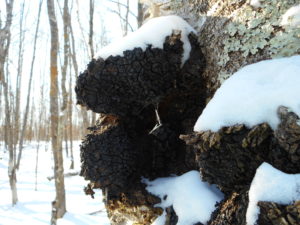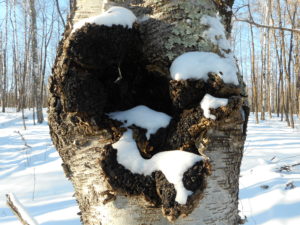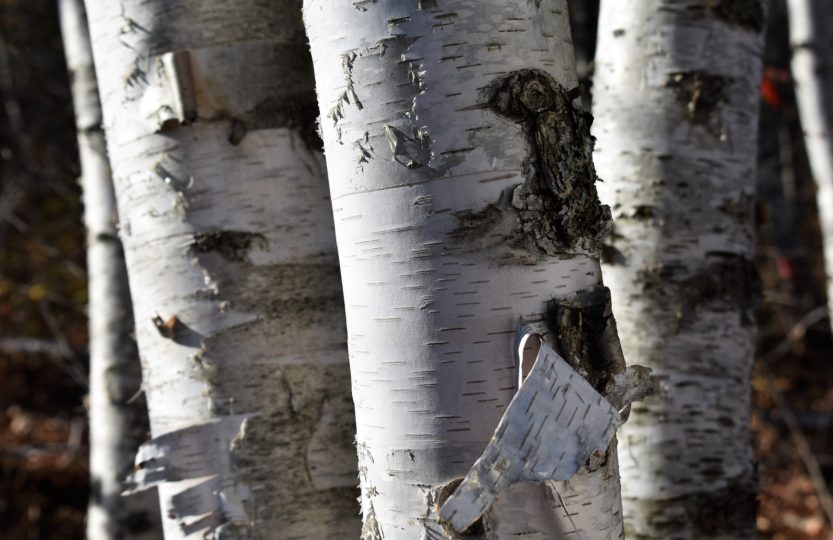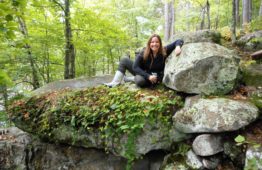“Medicines grow all around us. When we start to open ourselves to these medicines of the natural world and start developing relationships with these allies, we realize they become our friends. They show up and are there right when we need them the most. Mother earth continually knows exactly how to best nourish and heal our very being. It’s like a mirror that continually reflects our constantly changing healing needs. In truth, we are SO VERY taken care of on this planet. It’s easy to forget this at times, but when we return to this knowing, we realize we are right where we need to be.” –Sheila Coughlin
The chaga mushroom reminds me of this message. It reminds me that nature knows best and will offer it’s healing when the time is needed. For years, my family and I searched the woods on many of hikes scanning stands of birch trees for chaga, highly prized for its healing properties. Until a few years ago, all of our search attempts came up empty-handed. Now, everywhere we turn we stumble across it. Throughout the year, we keep track of these chaga findings, and in the winter-time, we harvest what we will need for the next year.
What is Chaga and how can I find it?
The chaga mushroom is regarded as a superfood, and its health benefits are highly documented. Chaga is a parasitic fungus that is found in colder climates mainly in the birch forests of the northern hemisphere. Its range includes the northern parts of the United States, Canada, Russia, Korea, and Eastern and Northern Europe. This AMAZING mushroom doesn’t look much like a mushroom at all. It appears more like a blackish, charcoal-like growth that forms mainly on birch trees. Some people have also reported that it occasionally grows on elm and alder trees. In getting to know this mushroom, I would suggest sticking to scanning the birch trees you encounter on your hikes. Once you find your first chaga mushroom, you’re future finds should be unmistakable.
 Chaga, Inonotus obliquus, is a bulging canker that can grow up to a foot or more across. It’s black, heavily cracked surface sometimes gives you a peek at the golden, yellow-brown interior which is actually the medicinal part of the mushroom that you want to use. Please note that there are no gills, pores, or teeth on chaga. There are no poisonous look-alikes and no other mushrooms that resemble chaga. Utilizing a good mushroom field guide and cross checking the characteristics across several resources is a good practice to get into.
Chaga, Inonotus obliquus, is a bulging canker that can grow up to a foot or more across. It’s black, heavily cracked surface sometimes gives you a peek at the golden, yellow-brown interior which is actually the medicinal part of the mushroom that you want to use. Please note that there are no gills, pores, or teeth on chaga. There are no poisonous look-alikes and no other mushrooms that resemble chaga. Utilizing a good mushroom field guide and cross checking the characteristics across several resources is a good practice to get into.
 Some people new to identifying chaga have mistaken tree burls for the fungus. Tree burls which commonly grow on oak trees can be found on numerous other tree species. Look closely. Burls are actually part of the tree. They are not a separate species. The color of the burl resembles the bark of the tree. Chaga, however, is black with a cracked surface, and it appears as a completely separate species from that of the host tree. Wildfoodism has an excellent article to help you distinguish between the two. Definitely, very helpful to the beginner.
Some people new to identifying chaga have mistaken tree burls for the fungus. Tree burls which commonly grow on oak trees can be found on numerous other tree species. Look closely. Burls are actually part of the tree. They are not a separate species. The color of the burl resembles the bark of the tree. Chaga, however, is black with a cracked surface, and it appears as a completely separate species from that of the host tree. Wildfoodism has an excellent article to help you distinguish between the two. Definitely, very helpful to the beginner.
Always have a professional verify any wild food or medicine before considering its harvest. The mushrooms and plants that I harvest for my own personal use and the use of my family are ones that I have become familiar with through years of experience and research. One of the experiences that I cannot recommend enough is finding a professional to help aid in the identification of various mushrooms and plants. For years, I worked as an assistant to a research botanist familiarizing myself with the characteristics and identification of many wild foods that I now personally collect. Finding and joining a local mycology club in your area could be a great start to finding an expert who you could trust with verifying your mushroom find.
What are the Health Benefits of Chaga?
People have used this mushroom for many centuries in the East. It has just more recently become better known in the Western world. Indigenous people have known this medicinal mushroom for centuries. Before I share any of these benefits, I would like to share a belief that I have about the medicines of the natural world. Respect and relationship is key. It’s like asking a friend for help. If you develop a great relationship based on respect, your friend is likely to help you out. Don’t let it be one-sided. If the relationship is just about take, take, and more take, your friend is not likely to help you. Expecting a medicinal mushroom or plant to benefit you simply because of its “known” properties is strictly science. It leaves out the spirit. It is based on the analysis of its components, studies, and documented history of use. I believe science and spirit connect. There is no separation.
I will get into proper, respectful harvest in a future blog post. For now, I would like to say that I believe the natural world wants to help us. I believe that the healing powers of these medicines want to aid us in restoring and healing our personal well-being. I also believe that they want to be around for a long time aiding us in this healing. Let’s start off with a respectful way of looking at these “benefits” and realize that approaching these medicines with a humble, grateful heart void of selfishness is a good place to start. Only collecting what you need and harvesting properly can help avoid the exploitation of nature’s miraculous resources. I will get more into this later.
Chaga is an AMAZING ally! It is highly nutritionally dense, and its power comes from the force of actual trees. It is excellent for strengthening your immune system, inhibiting inflammation, and lowering blood glucose levels. As a source high in antioxidants, it can help lower cholesterol, lower blood pressure, and slow the physical signs of aging. People who drink chaga tea on a regular basis tend to live longer. Chaga prevents the development, growth, and spread of cancerous cells. It has also been shown to inhibit HIV-1 protease which is an enzyme that is essential for HIV to replicate and infect additional cells. The power of the birch tree’s betulin and betulinic acid is found in the chaga mushroom. These compounds aid against the Herpes Simplex type 1 virus, ECHO 6 virus, and as before-mentioned HIV. Medical News Today talks about some of these benefits. They also have a great list the vitamins, minerals, and nutrients that the chaga mushroom is rich in.
This was Part 1 of Exploring Chaga. Check out Part 2 to explore how to harvest, store, and make chaga tea!


